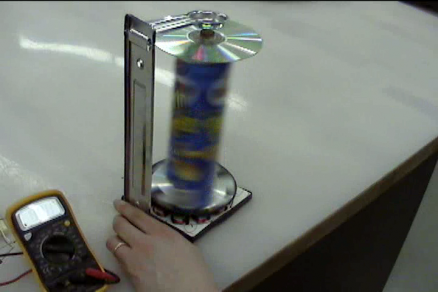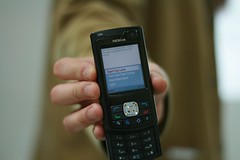Major Studio: Interactive
The Final Project
The Pringles Wind Turbine (a.k.a. Power Leech or Pleech) is an attempt to turn simple items found at the hardware store and elsewhere into a working low-voltage power supply. It is also the process for creating the turbine, designed so that other people may reproduce the product themselves.
Final paper pdf is attached below. The accompanying website for the instructable is here.
- Mike's blog
- Comments
- Read more



- 5344 reads
Made Make!
The Pleech Instructable appeared on the MAKE: Blog today.
This is great for the project. One of the points I drove home during my presentation was that I wanted the Pleech to be as much about the process of building one and sharing improvements with people as it is the end product. Hopefully wider public exposure will help bring more people into this process and start a good debate on the best way to build things like this.
- Mike's blog
- Comments



- 7347 reads
Preaching About Sydewynder
I had a great time at the Mobilized conference this past weekend. I taught a brief workshop on Sydewynder to the folks there, and I got a pretty good response. Here's a Flickr photo from the event:
Thanks again to Paul Notzold for sharing his computer and running
- Mike's blog
- Comments
- Read more



- 4836 reads
The Process for the Product
It is finished:
Pringles Wind Turbine (Pleech) - Version One
Well, actually, it's only just now getting started, really. The instructable is part of a hopefully ongoing process for refining the Pleech concept by harnessing the power of the instructables community. It's only been up for a few hours and already has a fan! Woowee!
- Mike's blog
- Comments



- 5165 reads
Photos From Yesterday
Just some more data for you from yesterday's events. Here's me at the end of the table studiously assembling my MintyBoost:

Image licensed under the CC-BY-NC-ND. Thanks to pt for the image.
And here's me with a completed ShakeLight:

- Mike's blog
- Comments



- 5070 reads
In User Land
I went to the Bent Festival at Eyebeam today--sorta. I didn't do the music--noise music makes me want to stick icepicks in both ears and both eyes. In fact, I think the Max/MSP teachers at Parsons next semester should hoist noise "musicians" out the window until they apologize for making our collective heads compress every time yet another one "discovers" how to modulate sawtooth waves with the fucking serial-in off a potentiometer circuit. It's a trick--get an ax.
I digress.
The classes I went to were fantastic and related very well to the user research I am doing for my Pleech project. The first was for a build of the MintyBoost, taught by its inventor, Limor Fried. Not only is it charging my wife's iPod as I write this (thanks for the guinea pig, hon!), it has the right kind of electronics (1.5V to 4.5V in, 5.0V out, 350mA max) that could power the kind of devices I'm interested in. This could be the supply end of the Pleech, minus the two AA batteries.
- Mike's blog
- Comments
- Read more



- 5606 reads
Pleech Prototype: Building, Testing, Tearing Apart
This week, I started building the prototype of my Pleech, the power leeching wind turbine.
The first thing I did was to assemble all the parts I could find. These included:




With these pieces together, I began the assembly process.
- Mike's blog
- Comments
- Read more



- 4685 reads
More Process
Heh. So, I just realized that I forgot to tag the last entry which would have put the previous Process post appear in the MS:I blog area. Dumb. No wonder Yury didn't see it.
I'm thinking about the Savonius Turbine in particular because of projects like
PicoTurbine.
At 300 windings per stator, the basic version of the PT should be able to produce between two and three volts, according to the authors. The plans have a pretty great discussion of the possible power coming out of the turbine.
- Mike's blog
- Comments
- Read more



- 4785 reads
Process Illustration
For my Pleech project, I am trying to develop a low-cost, low-power, easily assembled generator that can be fixed to walls, fan outlets, and other infrastructure in order to generate environmentally friendly electricity for physical-computing graffiti and sentiti applications.
(Note: "sentiti" is my own coinage. It refers to any illicit sensor that can be placed in much that same way as graffiti. Think of it as an unauthorized reading as opposed to an unauthorized writing.)
- Mike's blog
- Comments
- Read more



- 4920 reads
Concept Narrative
So, I'm not sure how to lay this over my Venn or mind map, but I'll try to make this work textually.
My idea is called Pleech. It is a device that will generate power, via magnetic induction, from mechanical moving parts, similar to how some bicycle power generators work.
It is designed for activists, hacktivists, graffiti artists, and others interested in installing low power electrical work in areas without access to grid power or easy change of batteries. The Pleech will be left in place for as long as it is allowed to exist, and the public is welcome to plug in their own work into it once it is encountered.
- Mike's blog
- Comments
- Read more



- 3656 reads
tags
Copyright Mike Edwards 2006-2009. All content available under the Creative Commons Attribution ShareAlike license, unless otherwise noted.






